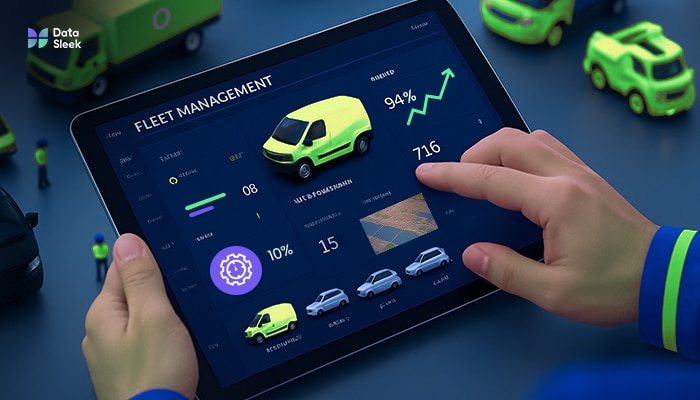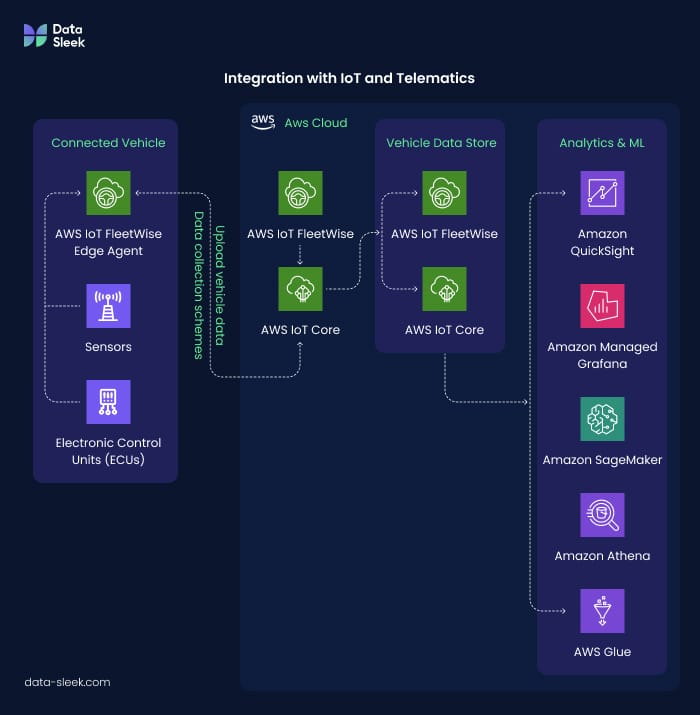In today’s rapidly evolving business landscape, fleet management has become increasingly complex and data-intensive. Transportation companies are facing unprecedented challenges in managing their vehicle fleets efficiently while trying to extract meaningful insights from the massive volumes of data generated daily. As the transportation and logistics sector continues to grow—with the U.S. logistics market expected to reach $236.41 trillion by 2027—organizations need robust data solutions to maintain their competitive edge.
At Data-Sleek, we understand that effective fleet management requires more than just tracking vehicles; it necessitates a comprehensive data strategy that transforms raw information into actionable intelligence. This blog explores how cloud-based data warehousing solves the critical data challenges in fleet management and drives operational excellence.
The Current Data Challenges in Fleet Management

1. Data Volume and Complexity
Fleet managers are drowning in data. From vehicle telematics to driver behavior, fuel consumption to maintenance records, the sheer volume of information is overwhelming. Studies show that fleet managers spend up to 40% of their time on administrative tasks, trying to keep track of vehicle maintenance schedules, driver logs, and route planning. This administrative burden drains valuable time and increases the risk of human error, leading to inefficiencies and higher operational costs.
2. Data Silos and Integration Issues
One of the most significant challenges in fleet management is the fragmentation of data across multiple systems. Maintenance records might exist in one system, while telematics data resides in another, and fuel consumption in yet another. These data silos prevent organizations from seeing the complete picture, making it difficult to make informed decisions. Integration complexities present significant challenges when implementing unified fleet management solutions, requiring robust data management strategies to overcome.
3. Real-time Data Processing Requirements
Modern fleet operations require real-time data to optimize performance. Fleet management demands real-time tracking capabilities to monitor vehicle location and status, enhancing asset visibility and security while optimizing routes based on current conditions. Without the ability to process and analyze data in real-time, fleet managers can’t respond promptly to changing conditions, resulting in missed opportunities and increased costs.
4. Data Security Concerns
With the increasing reliance on digital systems, data security has become a paramount concern for fleet management. Sensitive information about vehicles, drivers, and operations must be protected from unauthorized access and cyber threats. Data security remains a major concern, requiring implementation of encryption, access controls, and regular security audits to protect sensitive fleet information.
5. Analytics and Reporting Difficulties
Having data is one thing; deriving meaningful insights from it is another. Traditional fleet management struggles to turn collected data into actionable insights that can drive business decisions and operational improvements. Many organizations lack the tools and expertise to analyze fleet data effectively, leading to missed opportunities for optimization and cost savings.
How Cloud-Based Data Warehousing Solves These Challenges
1. Centralized Data Management
Cloud-based data warehousing provides a centralized repository for all fleet-related data, eliminating silos and creating a single source of truth. Solutions like those offered by Data-Sleek centralize data across assets, drivers, fuel, parts, costs, and more — enabling more informed decisions, improved performance, and the ability to scale operations at a glance. This centralization ensures that all stakeholders have access to the same information, fostering collaboration and consistent decision-making.
2. Real-time Monitoring and Analytics

Modern cloud data warehousing platforms enable real-time data processing and analytics, providing fleet managers with up-to-the-minute insights. IoT fleet management and telematics solutions provide real-time insights into performance, maintenance, and monitoring across a vehicle fleet, helping to improve savings, manageability, and visibility. This capability allows organizations to respond quickly to changing conditions, optimize routes based on traffic and weather, and address issues before they escalate.
3. Predictive Maintenance Capabilities
By leveraging advanced analytics and machine learning, cloud-based warehousing solutions can predict maintenance needs before failures occur. IoT-enabled systems continuously gather data on vehicle health, detecting anomalies and potential issues in real-time. Through predictive analytics, fleet managers can anticipate maintenance requirements before critical failures occur. This proactive approach reduces downtime, extends vehicle lifespan, and lowers maintenance costs.
4. Enhanced Security Features
Cloud service providers implement robust security measures to protect sensitive data. Cloud service providers typically implement cybersecurity best practices to protect valuable applications and data resources, offering secure access with methods such as two-factor authentication to minimize unauthorized access. Data-Sleek ensures compliance with relevant regulations and industry standards, giving fleet managers peace of mind regarding their data security.
5. Scalability and Flexibility
As fleet operations grow, their data needs evolve. Cloud computing allows for quick scaling of resources to meet fluctuating demands, ensuring that fleet management systems can grow alongside the business. This scalability eliminates the need for significant upfront investments in infrastructure and allows organizations to pay only for the resources they use.
Implementation Strategy for Cloud-Based Fleet Data Warehousing
1. Assessment and Planning
The first step in implementing a cloud-based data warehousing solution for fleet management is to assess your current data infrastructure and identify your specific needs and goals. This involves:
- Evaluating existing systems and data sources
- Identifying key performance indicators (KPIs) and analytics requirements
- Determining critical data points that need to be captured and analyzed
- Defining security and compliance requirements
At Data-Sleek, our consultants work closely with you to develop a comprehensive implementation plan that aligns with your business objectives and addresses your unique challenges.
2. Choosing the Right Solution
Selecting the appropriate cloud-based warehousing solution is crucial for success. A partner like Data-Sleek gives access to all fleet data in one cloud-based hub, offering a unified view of all assets. Managers can assign, monitor, and access inspections; view repair histories; identify vehicles that need replacing; and configure customizable alerts based on specific needs.
Our team helps you evaluate different platforms and technologies based on your specific requirements, considering factors such as:
- Scalability and performance needs
- Integration capabilities with existing systems
- Security and compliance features
- Cost considerations
- Analytics and reporting capabilities
3. Integration with IoT and Telematics

Modern fleet management relies heavily on IoT devices and telematics to collect real-time data from vehicles. Using sensors and telematics technology, IoT gathers real-time data on vehicle location, condition, and driver behavior, helping to optimize fleet management, streamline logistics, and ensure regulatory compliance.
Data-Sleek helps you integrate these data sources with your cloud-based warehouse, ensuring seamless data flow and real-time analytics capabilities. Our solutions support various data types and formats, making it easy to consolidate information from multiple sources.
4. Data Migration and Governance
Moving existing fleet data to a cloud-based warehouse requires careful planning and execution. Our team at Data-Sleek guides you through this process, ensuring data integrity and minimizing disruption to your operations. We establish robust data governance protocols to maintain data quality, security, and compliance throughout the data lifecycle.
Key aspects of our data governance approach include:
- Data quality assessment and cleansing
- Metadata management and documentation
- Access control and security measures
- Compliance with relevant regulations
- Data retention and archiving policies
5. Training and Adoption
Successful implementation requires user adoption and proper training. Workforce training is essential when implementing IoT and cloud-based solutions, requiring comprehensive programs on data analytics and cybersecurity. Data-Sleek provides comprehensive training and support to ensure your team can effectively use the new system and derive maximum value from your data.
The Future of Fleet Data Management
Emerging Trends
The fleet management landscape continues to evolve, with several trends shaping its future:
- Artificial Intelligence and Machine Learning: AI-powered analytics will provide increasingly sophisticated insights, from predictive maintenance to optimal routing and driver performance optimization.
- Advanced IoT Integration: More sophisticated IoT devices will collect even more detailed data, providing unprecedented visibility into fleet operations.
- Autonomous Vehicle Integration: As autonomous vehicles become more common, data management systems will need to adapt to handle new types of data and operational requirements.
- Sustainability Analytics: Environmental considerations are becoming increasingly important, and data warehousing solutions will evolve to help fleet managers optimize for sustainability goals.
The growing need for analytics and AI is at the forefront of many fleet management platforms to help combat driver shortage issues, improve employee driving experience, and allow real-time tracking, providing faster and more accurate data essential for identifying issues and solutions.
Integrating with Business Systems
To maximize the value of fleet data, it must be integrated with other business systems, such as:
- Enterprise Resource Planning (ERP) systems
- Customer Relationship Management (CRM) platforms
- Supply Chain Management systems
- Financial management software
Data-Sleek specializes in creating these integrations, ensuring that fleet data is part of a cohesive business intelligence strategy that drives overall organizational performance
Conclusion: Transforming Fleet Management with Data-Driven Insights
Cloud-based data warehousing is revolutionizing fleet management, providing the tools and capabilities needed to overcome the complex data challenges facing transportation and logistics companies. By consolidating data, enabling real-time analytics, predicting maintenance needs, enhancing security, and offering scalability, these solutions deliver tangible business benefits:
- Reduced operational costs
- Improved vehicle utilization and lifespan
- Enhanced driver safety and performance
- Optimized routing and fuel efficiency
- Better customer service and satisfaction
- More informed strategic decision-making
At Data-Sleek, we’re dedicated to helping fleet operators unlock the full potential of their data through customized cloud-based warehousing solutions. Our expertise in data management, combined with our deep understanding of fleet operations, enables us to deliver transformative solutions that drive real business results.
Ready to transform your fleet management with data-driven insights? Contact Data-Sleek today for a free consultation and discover how our cloud-based warehousing solutions can help you overcome your fleet data challenges and achieve operational excellence.
FAQ: Solving Data Challenges in Fleet Management with Cloud Solutions
1. What are the main data challenges in fleet management?
Fleet management faces challenges such as managing large volumes of data from various sources, data silos that prevent comprehensive insights, and the need for real-time data processing. These issues can hinder decision-making, increase costs, and reduce operational efficiency.
2. How does cloud-based data warehousing solve these data challenges?
Cloud-based data warehousing centralizes all fleet data, making it easier to manage and analyze. It provides real-time processing capabilities, integrates data from various sources, and ensures security, giving fleet managers the insights they need to optimize operations and reduce costs.
3. Why is real-time data important for fleet management?
Real-time data allows fleet managers to track vehicle performance, monitor locations, and adjust routes immediately based on live conditions. This improves efficiency, enhances decision-making, and minimizes downtime by addressing issues before they escalate.
4. How can cloud solutions improve fleet data security?
Cloud solutions offer enhanced security through encryption, secure access controls, and compliance with industry standards. These features protect sensitive fleet data from cyber threats and unauthorized access, ensuring compliance and peace of mind for fleet operators.







